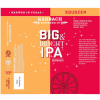Brewed for the 15th anniversary of the brewery - hence the square root of 225 - a bit like a sort of gag for our domestic market not ready to accept all tart beers, I decided to try. Couroussé by those nasty attitudes of American brewers make 22 different seasons in the same brewery, a bit like an excuse for beers nonsensical to 23% alcohol and very far from the Belgian seasons, I embarked on the adventure . Pale malt, aromatic hops, not always the same. And hop beer once brewed to 5% volume in old barrels St Bon-Chien, full of microorganisms on balance, I'm not 276 before the overflowing barrels.
I taste just me and the idea of cutting the old beer with the same but very fresh and bitter. The 225 season √ Was Born. I add "historical" season ahead for the U.S. market and I put it in my suitcase whenever I meet friends who hold bars. Amazing and rapid success, it becomes a sort of gateway into the wonderful world of beers acids, balanced, acidic and bitter at once complex and easily refreshing, moving beautifully bottled on wild yeasts.
Height of destiny, I talk Yvan Brasserie de la Senne, a geek and beer historian who told me that in Belgium at the time were often the old with the new beers, mixed history to get this weird taste acid.
Accordingly finally redefined the historical season (pronounced by pinching the nose) style, I cook up some variations. This time, allow me to use the first person singular, because when I came to work with my idea of St festival Bon-Chien, I promise you that my team took me for a fool. One more time.
French & Belgian-Style Saison
Brasserie des Franches-Montagnes






